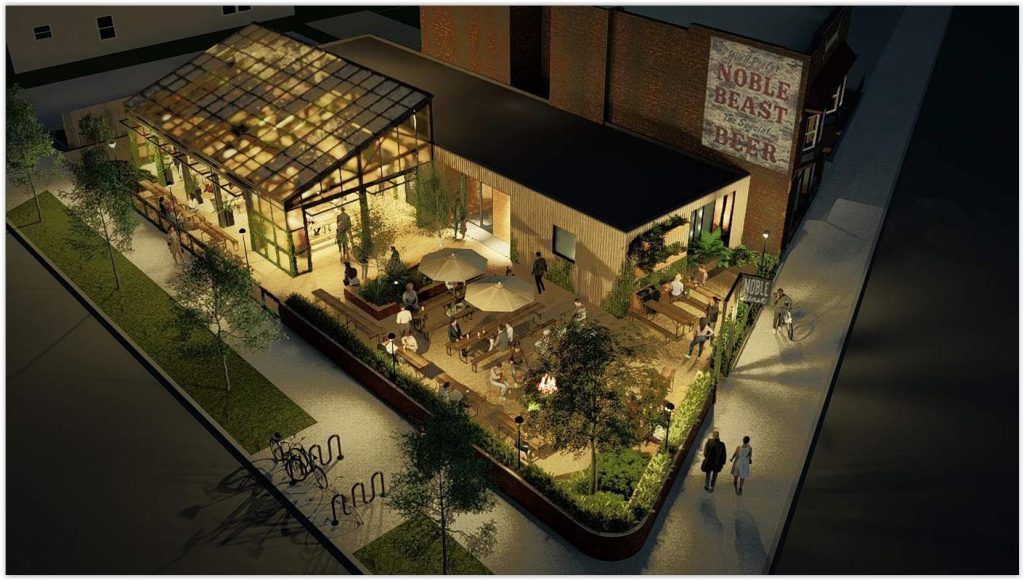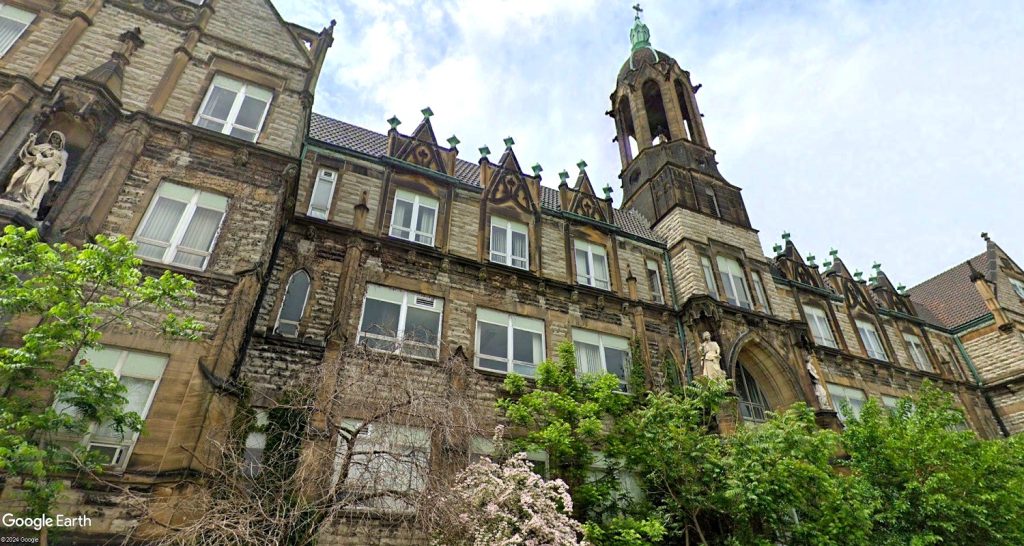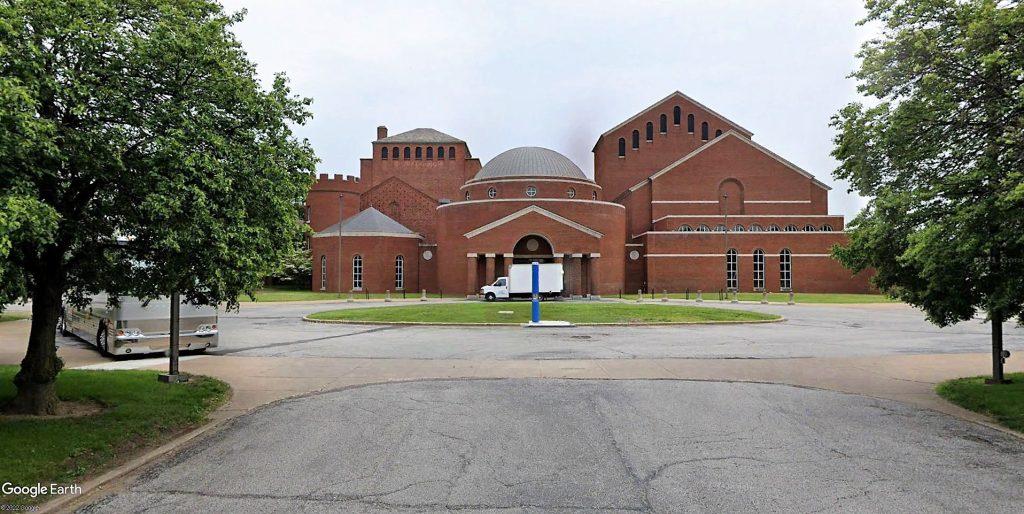 |
Van Aken District development rising
alongside the light-rail Blue Line’s
Warrensville station in Shaker Hts. |
See Part Two
HERE
In the 1990s, the Greater Cleveland Regional Transit Authority was considering extending the Red Line into Berea. Planners touted the economic development potential of the rail line. So a group of elder Berea residents who apparently hadn’t ever ridden the Red Line before took a driving tour of the areas around some of the existing Red Line stations.
What they saw were sprawling parking areas, aging or abandoned industrial buildings, used-car lots, self-storage facilities and other unsightly land uses. The elder Berea residents understandably found it difficult to believe that the Red Line extension would be an asset for their community. Little did they know that in other metro areas with new rail and bus rapid transit (BRT) lines, development arrayed in a neo-traditional land use style was popping up around rail and BRT stations. It’s called Transit-Oriented Development (TOD).
More of an adjective than a noun, TOD describes a land use theme in which a transit stop is the epicenter of a densely developed, attractive public realm surrounded by mixed-uses in a walkable setting. It’s a setting that produces for transit more ridership than a station surrounded by park-n-ride lots. In Greater Cleveland, the usefulness of and benefit from its rail/BRT transit system is limited by the land uses surrounding its stations. Here, many drive or take a bus to catch the train (Clevelanders call it “The Rapid”) and ride it to and from work or school in downtown Cleveland. That’s worth only two transit trips a day.
Rail/BRT transit systems in most other metro areas have more ridership because they are “all-purpose” systems. They have more stations that are closely surrounded by lots of residents, jobs, retail and civic uses like libraries, recreation centers, and schools including those that offer career development. They are multi-purpose rail/BRT systems along which a comfortable lifestyle can be sustained without depending on a car. In other metro areas, this transit ecosystem was built by the private sector in response to growing populations and worsening road traffic conditions. Greater Cleveland lacks those stimuli for TOD.
Greater Cleveland does have other TOD stimuli that are just as important but depend on more public sector involvement — namely addressing a worsening physical disconnect between jobs and job seekers. In Greater Cleveland, only 10 percent of available jobs are within a 60-minute transit commute. Many available jobs are therefore left unfilled or have a smaller pool of labor available to fill them, raising costs for employers. This also keeps many residents unemployed. The disconnect has manifested itself into some inner-city neighborhoods experiencing high concentrations of poverty. The overall poverty rate in Cleveland is near 30 percent.
There are two basic alternative responses to this challenge — either extend the transit system farther out to where the new jobs are or attract jobs and residents to within walking distance of existing, high-frequency transit. The first option simply is not possible to any great degree, absent new revenue sources for transit. Northeast Ohio transit agencies are facing flat or declining operating funding from countywide sales taxes, as well as fewer state and federal capital improvement funds. Additionally, expanding transit farther out into sprawling, low-density, less walkable areas produce proportionately higher costs and lower revenues for each new transit vehicle service-mile added.
The second option isn’t necessarily cheap or easy either. Many of the underutilized properties within walking distance of existing rail/BRT stations in Greater Cleveland are problematic. Some have contaminated soil conditions due to decades of pre-regulatory commercial activity that involved the use of toxic chemicals. Other properties are tied up in protracted legal battles. And some underutilized properties have owners who don’t want to develop or sell their land despite the obvious public benefits from developing their transit-accessible land with more productive uses.
Beyond the public benefit aspects of TOD that include less energy used and pollution emitted from lifestyles based on walking, biking and transit, there’s actually a free-market angle to having more TOD in ?Cleveland. The two largest population demographic groups — Baby Boomers and their Millennial children — are seeking low-mileage lifestyles. Either they don’t own cars or they want to downsize by keeping just one car and using it less so it lasts longer. They also don’t want to rely on their car for everything. If Greater Cleveland won’t avail this lifestyle in sufficient quantity, it will lose its Baby Boom and Millennial populations to metro areas that do.
Fortunately, Greater Cleveland is waking up to these threats and opportunities. Its strengths are its rail/BRT system which offer an asset that many cities of similar size or even larger lack. Greater Cleveland also has underutilized land near its rail/BRT stations that are both a weakness (because they don’t produce ridership now) and an opportunity (because they can offer a clean slate to start over with great urban design). Another weakness is that the region’s public and private stakeholders need more education on the benefits of TOD, and that it already possesses but doesn’t utilize public and private financing tools to plan, prioritize and develop TOD.
 |
| East 116th Street station, proposed TOD concept. |
An effort to utilize and focus more public financing tools to incentivize TOD in specific focus areas is underway at the Northeast Ohio Areawide Coordinating Agency (NOACA), in partnership with the Greater Cleveland Regional Transit Authority, City of Cleveland and neighborhood development organizations. Three initial focus areas were identified by NOACA:
These three locations were identified by NOACA during a prior stage of developing a TOD scorecard and station typologies. All three sites have a market potential for TOD, but require public investment to upgrade transit facilities, improve sidewalks, narrow street widths, realign streets and enhance public realms to improve their pedestrian experiences.
There are also is zoning and funding available to help private real estate developers construct TOD. One of the most significant changes is in Congress’ 2015 passage of the five-year surface transportation program authorization, called the Fixing America’s Surface Transportation (FAST) Act. The FAST Act expanded eligibility of the
Transportation Infrastructure Finance and Innovation Act (TIFIA) to provide low-interest loans, loan guarantees and lines of credit for up to 33 percent of costs of local TOD infrastructure and are applicable to all GCRTA rail and BRT station areas.
FAST also expanded the use of the $35 billion
Railroad Rehabilitation & Improvement Financing (RRIF) program to support TOD infrastructure and development finance near passenger railroad stations, such as the Amtrak station in downtown Cleveland. RRIF loans can pay for 100 percent of project costs.
State, local and locally utilized federal incentives can also be used to incentivize TOD, such as:
-
Incentive Districts: Ohio law allows for the creation of Incentive Districts, such as around transit stations where
Tax Increment Financing (TIF–the additional tax revenue created by a public or private investment) can be broadly applied to TOD infrastructure.
-
New Market Tax Credits: This federal program is often used by the Greater Cleveland Partnership (GCP) and
Enterprise Community Partners (ECP) to induce private equity and/or debt capital at below-market terms for real estate developments, but GCP/ECP does not award credits based on transit-accessibility.
-
Affordable Housing Programs:
Ohio Housing Finance Agency runs its own programs and allocates the federal Low Income Housing Tax Credit to real estate developments. Transit accessibility is an important factor in awarding these credits.
-
Ohio Brownfields Funding: the
Ohio Development Services Agency offers a menu of state and federal programs. Many properties near transit stations are polluted and require cleaning before they can be returned to productive use.
Private developers aren’t waiting for TOD pilot projects. Station-area developments, most of which are utilizing TOD guidelines, are popping up around GCRTA rail and BRT stations. In the next article, I’ll cover that part of the story — which has the makings of a coming boom in station-area developments. Just about every significant real estate development in Cleveland and its inner-ring suburbs is happening within walking distance of a rail/BRT station.
See Part Two HERE
END






Comments are closed.